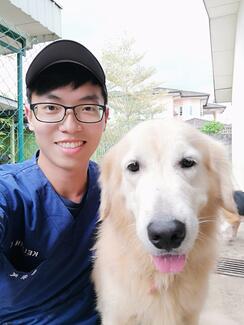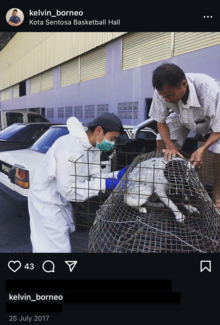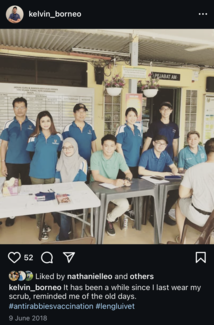
Your Work
Where do you work?
Mainly at PM Veterinary Clinic, goes to rural areas such as Sri Aman and Lundu on monthly basis
When did you start your work?
2017
What rabies elimination work do you do?
Dr. Kelvin’s pioneering efforts in combating rabies have set a remarkable standard for community health initiatives. His journey began during the harrowing rabies outbreak in Sarawak in 2017, where he was among the first veterinarians from the private sector to volunteer for mass vaccination campaigns in Serian, where the first human rabies case occured. His dedication extended beyond the field as he championed rabies awareness through engaging public talks at kindergartens, local halls, markets, and festivals.
Since 2021, Dr. Kelvin has organized annual World Rabies Day events in his clinic, such as buy 1 free 1 rabies vaccine. Tirelessly traveling to rural communities like Sri Aman and Lundu every month to administer rabies vaccinations, his unwavering commitment over the past four years has significantly bolstered local efforts against this deadly disease.
In 2023, as the President of the Sarawak Veterinary Association (SVA), Dr. Kelvin spearheaded a groundbreaking collaboration with the Institute of Health and Community Medicine (IHCM) and the University of Malaysia Sarawak (UNIMAS). This partnership resulted in the development of a novel system for collecting and analyzing saliva samples from suspected rabid animals. This initiative, which continues to operate successfully, has provided a crucial tool in the fight against rabies.
On September 27th and 28th, 2023, Dr. Kelvin orchestrated a landmark free rabies mass vaccination campaign for dogs and cats—an effort not covered by local government support. The campaign, which vaccinated 262 animals, garnered significant media attention from TVS (TV Sarawak) and TEA FM, and drew support from SSPCA and local council representatives. This event not only provided vital vaccinations but also heightened local awareness about rabies prevention.
Furthermore, on June 11th, 2024, Dr. Kelvin addressed over 400 students and teachers at Chung Hua Middle School No.4. His impactful presentation, which included harrowing real-life cases of rabies, educated the audience on prevention strategies and emergency responses to potential rabies exposure.
Despite facing financial constraints, Dr. Kelvin remains a beacon of hope and a driving force in rabies awareness. His relentless dedication and innovative approaches continue to inspire and make a profound impact on public health in the region.
Your Work in Numbers
Number of animals vaccinated against rabies (last year) 1801
Number of animals sterilized (last year) 1062
Number of children educated (last year) 100
Number of adults educated (last year) 500
Number of Professionals trained (last year) 0
Your Work's Impact
Dr. Kelvin’s work has profoundly transformed his community’s approach to rabies prevention and public health education. His pioneering efforts have significantly mitigated the impact of rabies, a dangerous and often fatal disease, through a combination of direct action, public education, and innovative solutions.
1. Enhanced Public Health Response: By volunteering during the critical rabies outbreak in 2017 and leading subsequent vaccination campaigns, Dr. Kelvin has played a crucial role in controlling the spread of rabies in Sarawak. His ongoing commitment, exemplified by his monthly vaccinations in rural areas, has directly contributed to the reduction of rabies cases and increased community immunity.
2. Increased Awareness and Education: Dr. Kelvin’s extensive public outreach, including talks at kindergartens, markets, and festivals, has educated thousands about rabies prevention. His annual World Rabies Day events and educational talks in schools have raised awareness among diverse age groups, equipping them with essential knowledge about rabies, its prevention, and emergency responses.
3. Innovative Solutions and Collaboration: His leadership in developing a novel system for analyzing saliva samples from suspected rabid animals has enhanced diagnostic capabilities and contributed to more effective disease management. This collaboration with IHCM and UNIMAS has fostered a more robust local and regional response to rabies.
4. Community Engagement and Media Outreach: The successful rabies vaccination campaign he organized in 2023, which attracted significant media attention, not only vaccinated 262 animals but also amplified the message of rabies prevention to a wider audience. The involvement of local media and support from community organizations further highlighted the importance of vaccination and preventive measures.
5. Youth Education and Empowerment: Dr. Kelvin’s recent talk at Chung Hua Middle School No.4 reached over 400 students and teachers, empowering them with knowledge about rabies. His impactful presentation has fostered a generation of informed young individuals who are now advocates for rabies prevention in their communities.
Overall, Dr. Kelvin’s tireless efforts have built a more informed, proactive, and resilient community, better equipped to handle rabies and other public health challenges. His work stands as a testament to the profound impact that dedicated individuals can have on public health and community well-being.
Partners
Government partners
Department of Veterinary Services Sarawak (DVSS)
Government collaboration:
7 Years
NGO Partners
Sarawak Society For The Prevention Of Cruelty To Animals (SSPCA)
Save Our Strays (SOS)
Suflora Pets Garden (Location: Lundu)
Mimi and Friends (Location: Sri Aman)
NGO collaboration:
4 Years
Other partners
Mimi & Friends, Suflora Pets Garden
Other collaboration:
4 Years
Innovations and Learnings
What is innovative about your approach?
Dr. Kelvin has introduced several innovative approaches in his work to combat rabies, significantly enhancing both community health and disease management strategies:
Novel Diagnostic System: One of Dr. Kelvin’s most impactful innovations is the development of a novel system for collecting and analyzing saliva samples from suspected rabid animals. Collaborating with the Institute of Health and Community Medicine (IHCM) and the University of Malaysia Sarawak (UNIMAS), this system enables precise and efficient testing using PCR technology. This advancement has improved diagnostic accuracy and facilitated timely intervention, thereby strengthening the overall rabies control strategy.
Sustained Rural Vaccination Program: Dr. Kelvin has established a sustainable model for rabies vaccination in rural areas, particularly in Sri Aman and Lundu. His initiative to provide regular, monthly vaccinations in these underserved regions addresses a critical gap in rabies prevention and ensures consistent coverage. This approach not only enhances vaccine accessibility but also builds long-term immunity in areas at high risk of rabies.
Comprehensive Public Education Campaigns: Dr. Kelvin has designed and implemented extensive public education campaigns that leverage diverse platforms to raise awareness about rabies. His innovative use of local markets, festivals, and schools as venues for education ensures that the message reaches a broad audience. Additionally, his integration of real-life rabies cases into educational talks provides a compelling and relatable context, making the information more impactful and memorable.
Community-Centric Vaccination Drives: In response to local needs and gaps in government-supported vaccination programs, Dr. Kelvin organized a significant free rabies vaccination campaign for both dogs and cats. This initiative, which vaccinated 262 animals, demonstrated his innovative approach to filling gaps in public health services and mobilizing community support through media outreach and collaboration with local organizations.
Youth Engagement Through Schools: By engaging with high school students, Dr. Kelvin has pioneered a targeted approach to youth education on rabies prevention. His use of real-life case studies and interactive presentations in schools helps to educate and empower younger generations, creating a ripple effect of awareness and prevention strategies within families and communities.
These innovations have not only addressed immediate rabies-related challenges but have also set new standards for community engagement and disease management. Dr. Kelvin’s work exemplifies how creativity and dedication can lead to significant advancements in public health.
Lessons learned (Positive)
Dr. Kelvin’s work provides key lessons for public health initiatives:
Community Engagement: Actively involving communities through markets, festivals, and schools ensures that health messages reach a wide audience. Tailoring outreach to local contexts maximizes impact.
Sustained Efforts: Regular programs, like Dr. Kelvin’s monthly rural vaccinations, build trust and ensure ongoing protection, demonstrating the importance of persistence for long-term success.
Innovation: Developing a novel diagnostic system for rabies shows how technological advancements can enhance disease management and outcomes.
Collaboration: Partnerships with institutions like IHCM and UNIMAS highlight the effectiveness of pooling resources and expertise to tackle complex health challenges.
Service Gaps: Free vaccination campaigns, filling gaps left by government support, illustrate the impact of addressing service deficiencies directly.
Youth Education: Engaging students in schools fosters a culture of prevention and empowers them to spread awareness.
Media Utilization: Media coverage amplifies public health messages, increasing visibility and engagement.
Resilience: Despite financial constraints, Dr. Kelvin’s persistence underscores the importance of resilience in achieving public health goals.
These lessons emphasize the value of community involvement, innovation, collaboration, and persistence in improving public health.
Lessons learned (Negative)
Dr. Kelvin’s experiences reveal key challenges and lessons:
Limited Resources: Financial constraints can limit the effectiveness of public health programs. Adequate funding is essential for sustaining initiatives.
Dependence on External Support: Relying on external sources, like local government, can create service gaps. Consistent support from all levels is necessary for comprehensive coverage.
Logistical Issues: Vaccination in remote areas faces challenges such as transportation and infrastructure, requiring careful planning and resource management.
Communication Barriers: Reaching everyone with health messages can be difficult due to literacy, language differences, and misinformation. Multiple communication methods are needed.
Over-reliance on Individuals: Excessive dependence on one person’s efforts can be risky. Systematic support and collaboration are crucial for long-term success.
Sustaining Engagement: Maintaining community interest over time requires ongoing efforts and strategies.
Need for Data: Without proper data and feedback, assessing program impact and making improvements is challenging. Regular evaluation is important.
Effectiveness of Free Services: Free vaccination drives are more successful than paid campaigns, as they better encourage pet owners to participate.
Self-Reliance: Expecting others to support rabies awareness has proven unrealistic. Private sectors must lead these efforts independently.
These lessons highlight the need for adequate resources, systemic support, and proactive approaches in public health.
** All information adapted from the submitted nomination form**



